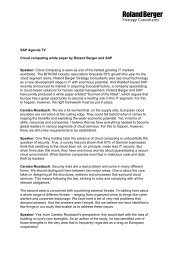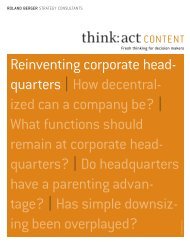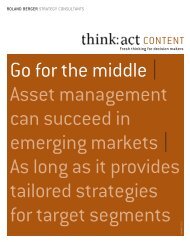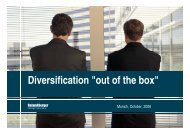Customer-centric retailing â Now you know what ... - Roland Berger
Customer-centric retailing â Now you know what ... - Roland Berger
Customer-centric retailing â Now you know what ... - Roland Berger
You also want an ePaper? Increase the reach of your titles
YUMPU automatically turns print PDFs into web optimized ePapers that Google loves.
PROF. NITIN SANGHAVIINTERVIEW<strong>Customer</strong>-<strong>centric</strong> <strong>retailing</strong>"The majority of retailers have not grasped thestory yet. They still lose sight of the customer."Nitin Sanghavi, Professor of Retail Marketing and Strategyat Manchester Business School.Prof. Sanghavi, could <strong>you</strong> please outline some of thekey trends in the European retail industry?We currently see a fundamental change in the consumermarkets. There is a shift taking place in consumer shoppingattitudes and buying behavior patterns. Consumersare becoming much more concerned about spending. Inaddition, we have to face some fundamental demographicand socioeconomic changes. Furthermore, the industryhas to deal with rising cost pressure. Retail prices aresuffering from stagflation or deflation in many productcategories. In this market situation it is very difficult toraise the prices and sustain them in response to increasingcosts. We have a very high level of ambiguity, uncertaintyand complexity among consumers and the markets.We have never faced a situation with a dynamic momentumlike this before.Offerings are managed in the stores using out-of-datemetrics, and nobody understands <strong>what</strong> sort of productsor services customers really want. Right or wrong?Yes, absolutely right. Many retailers have lost sight of thecustomer. They act without thinking about the customer.For categories, they think too much about sales volume,sales revenues and suppliers instead of understandingthe customers and specifically targeting them. Categorymanagement is all about defining ranges, recording allrelevant metrics on a category scorecard, organizationalskills, information technology and the relationship betweenmanufacturers and retailers. These elements need tobe aligned to the consumer. If they are not, in other wordsif there is no customer focus and no real understandingof the customer, then category management cannot beeffectively used as a tool.What's the conclusion of this? What kind of transformationdo <strong>you</strong> expect for the retail industry?This extremely harsh climate will leave its mark; retailerswill have to change and adapt. We will get much moreconsolidation in the marketplace compared to <strong>what</strong> wehave seen before. The number of players will disappearor will have to consolidate. At the end of the day, theconsumers will have access to a decreasing numberof retail brands.I would like to challenge <strong>you</strong> with the following theoryof European retail management: Traditional categorymanagement dominates; the industry is increasinglyrelying on volumes, sales, terms and promotional rebates.There is hardly any real focus on the customer.Nitin Sanghavi has been Professor of Retail Marketingand Strategy at Manchester Business School (MBS)since 1985, after holding senior positions for a numberof major retail and retail-related organizations in theUK and overseas. He is a frequent speaker at nationaland international retail conferences. He also acts asa non-executive director for several retail and retailrelatedorganizations in Europe and India.13
















